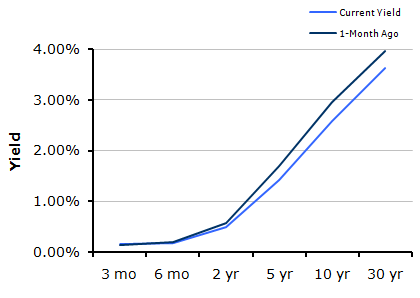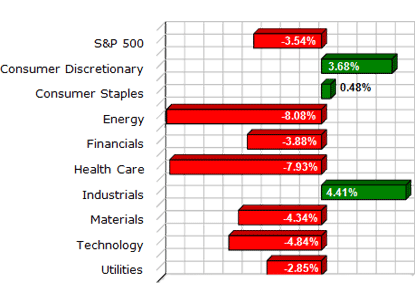
Market Commentary by Scott J. Brown, Ph.D., Chief Economist

There were several surprises in the economic data reports, mostly to the downside. The market took some comfort earlier in the week as the Producer Price Index (PPI) seemed to suggest that deflation was less likely to be a problem and that manufacturing output was strong in July. However, the core PPI (reported up 0.3%) was boosted by what is likely to have been a seasonal adjustment quirk in light motor trucks. Industrial production was boosted partly by a 9.9% jump in motor vehicle production, which reflected fewer-than-usual summer plant closings (prior to seasonal adjustment, auto output fell 20.3% in July).
On Thursday, the stock market was rattled by a further increase in initial claims for unemployment insurance benefits (which may or may not be distorted) and by a surprisingly weak Philadelphia Federal Reserve Index (-7.7, compared to expectations of +7.0).
Minneapolis Fed President Narayana Kocherlakota – who will vote on the Federal Open Market Committee (FOMC) in 2011 – said that the August 10 policy statement was misinterpreted by the financial markets. The Fed’s economic view was not any worse than the market consensus, he said, adding that the Fed’s policy move was not due to expectations of a double dip. Rather, low mortgage rates have led to faster mortgage prepays, thus reducing the size of the Fed’s balance sheet more than anticipated, Kocherlakota said. That led to the FOMC’s decision to reinvest principal payments in its mortgage-backed securities holdings into long-term Treasuries (to keep the size of the Fed’s balance sheet steady).
Next week, there is a good chance for surprises in the economic data (new home sales figures and durable goods orders are especially volatile). The excitement level should step up on Friday. The government’s estimate of second quarter growth is expected to be revised a full percentage point lower (from 2.4% in the advance estimate), reflecting a wider-than-expected trade deficit and lower-than-expected inventories (otherwise, the story is unlikely to change much). Fed Camp – the Kansas City Fed’s annual economic symposium – begins Thursday. Chairman Ben Bernanke will speak on Friday morning – his first public comments since the August 10 FOMC meeting – and the markets will be very interested in what he has to say.
Indices
| Last | Last Week | YTD return % | |
| DJIA | 10271.21 | 10319.95 | -1.50% |
| NASDAQ | 2178.95 | 2190.27 | -3.98% |
| S&P 500 | 1075.63 | 1083.61 | -3.54% |
| MSCI EAFE | 1461.14 | 1452.1 | -7.57% |
| Russell 2000 | 610.96 | 616.98 | -2.31% |
Consumer Money Rates
| Last | 1-year ago | |
| Prime Rate | 3.25 | 3.25 |
| Fed Funds | 0.25 | 0.25 |
| 30-year mortgage | 4.51 | 5.29 |
Currencies
| Last | 1-year ago | |
| Dollars per British Pound | 1.561 | 1.656 |
| Dollars per Euro | 1.282 | 1.425 |
| Japanese Yen per Dollar | 85.320 | 93.850 |
| Canadian Dollars per Dollar | 1.039 | 1.096 |
| Mexican Peso per Dollar | 12.728 | 12.864 |
Commodities
| Last | 1-year ago | |
| Crude Oil | 74.43 | 72.42 |
| Gold | 1223.53 | 943.88 |
Bond Rates
| Last | 1-month ago | |
| 2-year treasury | 0.49 | 0.57 |
| 10-year treasury | 2.58 | 2.95 |
| 10-year municipal (TEY) | 3.92 | 4.38 |
Treasury Yield Curve – 8/20/2010

S&P Sector Performance (YTD) – 8/20/2010

Economic Calendar
| August 23 | — | Chicago Fed National Activity Index (July) |
| August 24 | — | Existing Home Sales (July) |
| August 25 | — | Durable Goods Orders (July)
New Home Sales (July) |
| August 26 | — | Jobless Claims (week ending August 21) |
| August 27 | — | Real GDP (2Q10, 2nd estimate)
Consumer Sentiment (August) Bernanke Speaks (“Econ Outlook and Fed’s Policy Response“) |
| August 30 | — | Personal Income and Spending (July) |
| September 6 | — | Labor Day Holiday (markets closed) |
| September 21 | — | FOMC Meeting |
Important Disclosures
Past performance is not a guarantee of future results. There are special risks involved with global investing related to market and currency fluctuations, economic and political instability, and different financial accounting standards. The above material has been obtained from sources considered reliable, but we do not guarantee that it is accurate or complete. There is no assurance that any trends mentioned will continue in the future. While interest on municipal bonds is generally exempt from federal income tax, it may be subject to the federal alternative minimum tax, state or local taxes. In addition, certain municipal bonds (such as Build America Bonds) are issued without a federal tax exemption, which subjects the related interest income to federal income tax. Investing involves risk and investors may incur a profit or a loss.
US government bonds and treasury bills are guaranteed by the US government and, if held to maturity, offer a fixed rate of return and guaranteed principal value. US government bonds are issued and guaranteed as to the timely payment of principal and interest by the federal government. Treasury bills are certificates reflecting short-term (less than one year) obligations of the US government.
Commodities trading is generally considered speculative because of the significant potential for investment loss. Markets for commodities are likely to be volatile and there may be sharp price fluctuations even during periods when prices overall are rising. Specific sector investing can be subject to different and greater risks than more diversified investments.
Tax Equiv Muni yields (TEY) assume a 35% tax rate on triple-A rated, tax-exempt insured revenue bonds.
![]() Material prepared by Raymond James for use by its financial advisors.
Material prepared by Raymond James for use by its financial advisors.
The information contained herein has been obtained from sources considered reliable, but we do not guarantee that the foregoing material is accurate or complete. Data source: Bloomberg, as of close of business August 19th, 2010.
©2010 Raymond James Financial Services, Inc. member FINRA / SIPC.


